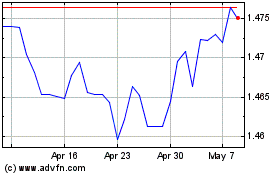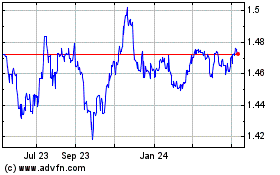Loonie Falls As Canadian Economy Contracts Unexpectedly
November 30 2018 - 3:25AM
RTTF2
The Canadian dollar drifted lower against its major counterparts
in the European session on Friday, as a data showed that Canadian
economy shrank unexpectedly in September driven primarily by lower
output across all goods-producing industries.
Data from Statistics Canada showed that GDP dropped 0.1 percent
on a seasonally adjusted monthly basis from last month, when it
rose 0.1 percent. The rate was forecast to remain unchanged.
On a year-on-year basis, GDP grew 0.5 percent in the third
quarter, following a 0.7 percent increase in the second
quarter.
The annualized rate of GDP slowed to 2.0 percent from 2.9
percent seen in the second quarter. Economists were looking for a
growth of 2.0 percent.
In a separate release, the Statistics Canada said that the
industrial product price index rose 0.2 percent month-on-month in
October, unchanged from the previous month. Economists had forecast
a 0.5 percent fall.
The raw materials price index fell 2.4 percent on a monthly
basis after falling 1.0 percent in the previous month. Economists
were looking for a decline of 5.3 percent.
Oil prices resumed declines amid worries about falling demand
after China reported its weakest factory growth in more than two
years.
Crude for January delivery dropped $0.87 to 50.64 per
barrel.
The currency traded mixed against its major counterparts in the
Asian session. While it fell against the greenback and the euro, it
held steady against the aussie and the yen.
The loonie slipped to a 2-day low of 1.3325 against the
greenback, off an early high of 1.3273. The next possible support
for the loonie is seen around the 1.35 level.
The loonie fell back to 1.5141 against the euro, not far from a
9-day low of 1.5149 seen at 6:15 am ET. On the downside, 1.53 is
seen as the next likely support level for the loonie.
Preliminary figures from the Eurostat showed that Eurozone's
consumer price growth slowed to its lowest level in three months in
November and the core inflation unexpectedly eased.
The consumer price index rose 2 percent year-on-year following a
2.2 percent increase in September. The slowing was in line with
economists' expectations.
The loonie pared gains to 85.20 against the yen and 0.9732
against the aussie, from its early highs of 85.46 and 0.9708,
respectively. The loonie is seen finding support around 84.00
against the yen and 0.99 against the aussie.
Euro vs CAD (FX:EURCAD)
Forex Chart
From Mar 2024 to Apr 2024

Euro vs CAD (FX:EURCAD)
Forex Chart
From Apr 2023 to Apr 2024
